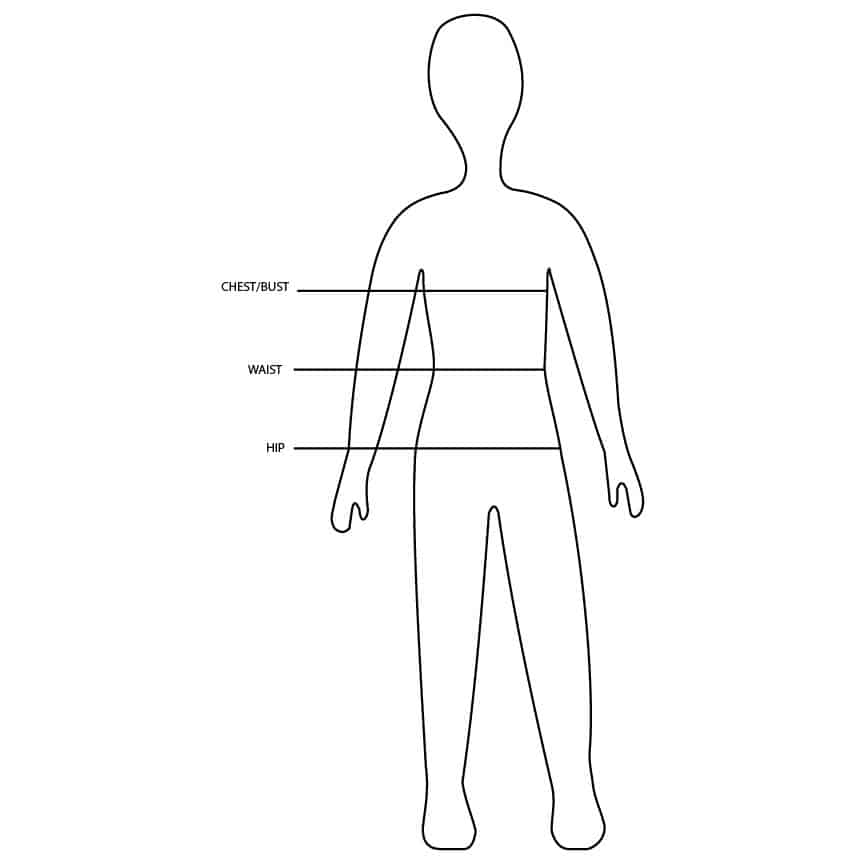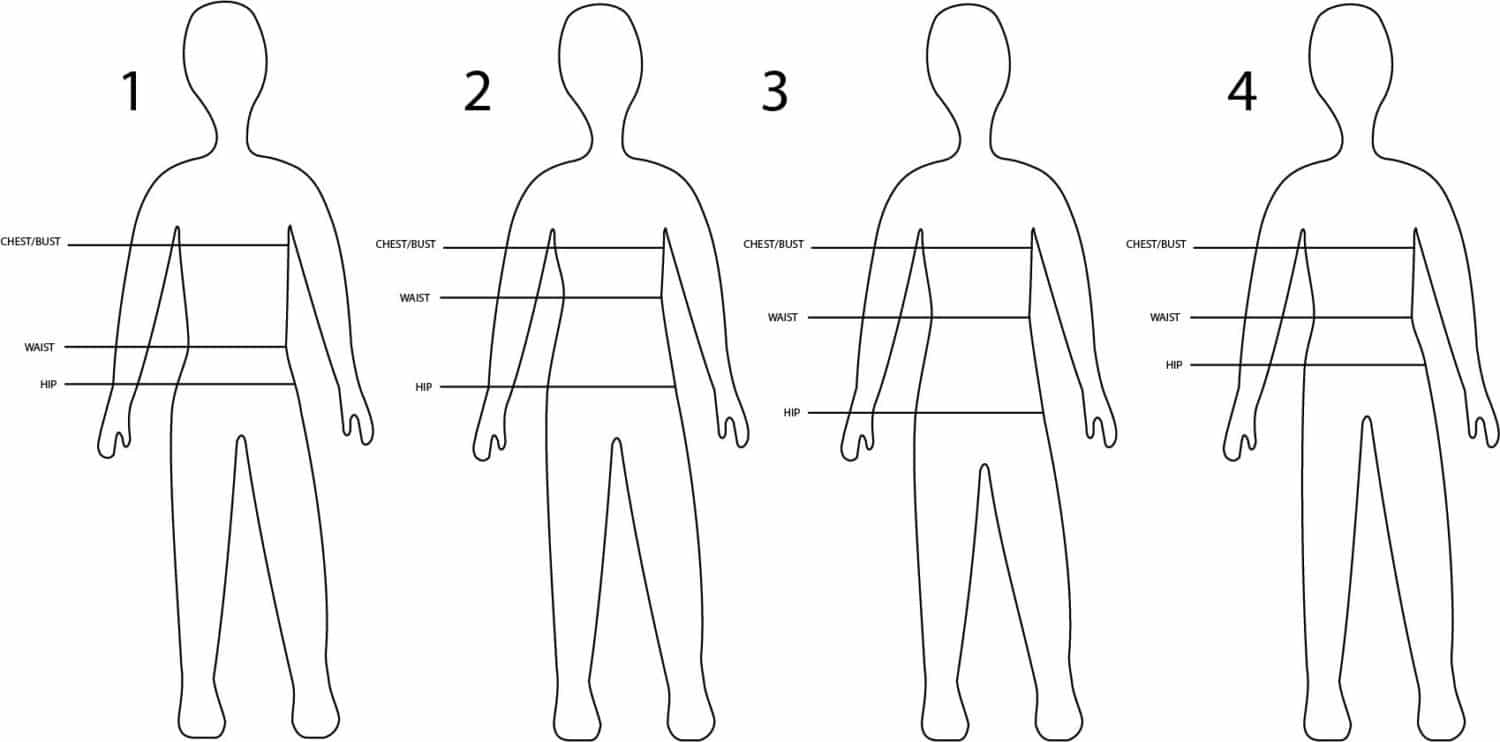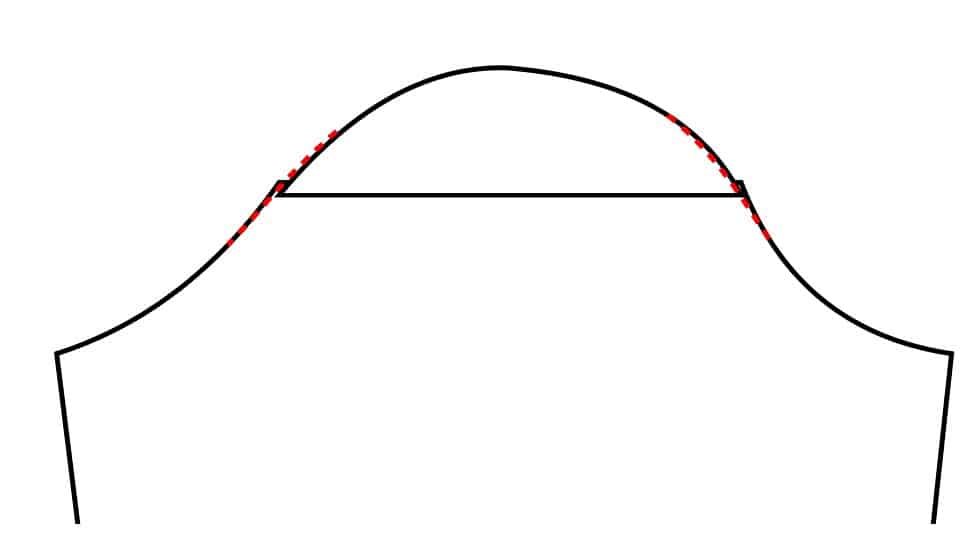If you wish to DOWLOAD this guide in PDF form, you can do so right here!
The entire reason I learned to sew is because my body doesn’t fit into any standard RTW (ready to wear) size chart. Not only are my bust, waist and hip measurments all in entirely different sizes, I am tall. Pushing six feet as a woman means the only thing I can buy at a mall is shoes. And ice cream. I do love a good chocolate fudge scoop.
One of the most common questions we get is ‘what height do you draft for?’. I could give you an easy answer. We follow ASTM for drafting so let’s say our women’s size chart is based on 5’7″ and our men’s on 5’10”. HOWEVER, assuming you’ll fit into a garment just because you are of average height is misguided.
If you simply add or subtract length at a hemline, yes, you’ll make the garment shorter or longer, but that won’t necessarily improve your fit all that much.
I also highly recommend you make these length adjustments BEFORE you go on to grading your garment for size. When you have your garment properly proportioned, it is much easier to then make changes to the width, etc.
You can have a long torso, short torso, long rise, short rise, long waisted, short waisted, long legs, short legs…. you get my drift. Let’s take the example of this person here. Let’s call them Sonny. Sonny is an adult of average height. You can see where I’ve marked Sonny’s chest/bust, waist and hip.

For a visual example, let’s take these four Sonnys. All four are the same height as our original Sonny, but with different proportions.
Sonny #1 is long waisted, while Sonny #2 is short waisted. Sonnys #3 & #4 are average waisted, but Sonny #3 has a long rise and shorter inseam, while Sonny #4 has a short rise and long inseam.

These are just examples. You may have a long waist and shorter inseam or vice versa… so many proportions! So how do you know where to adjust? My guess is you have a pretty good idea based on your RTW clothes. Do you feel like you constantly have to pull your tops down so the waist hits you in the right spot? Do you put on a pair of pants and the knees end up in your calf area?
Just like RTW, patterns are drafted on a set of averages. However UNLIKE buying your clothes at a store, you have the power to fit your pattern to your body to make your own custom clothes!
A Quick Note on Kids:
While all of the adjustments I’m going to talk about also apply to the kiddos, there is one big difference. Kids grow at all different rates, but generally speaking, height is the BEST indicator on what size to begin with. Kids tend to grow proportional to their height. Shoulders, head, feet, hands, etc change as the child grows upwards.
To give you an example, if you have a five year old child with chest/waist/hip measurements in the 18 month range, if you make a size 18 month lengthened to a size 5, it’s unlikely your child will be able to get the pants over their feet or a shirt over their head.
How To Adjust Your Pattern:
We are going to go through the most common of length adjustments., working from the top of the body on down. You may find you want to fine tune other pattern pieces even more (such as adjusting a hood height or making a pocket taller for larger hands). You will use the same methods for nearly any length adjustments you need to do.
ARMSCYE
The armscye of a garment is the arm opening. If your torso is longer from your neck/shoulder to your chest/bust point, you might find that underarms are often uncomfortably high in your armpit. Conversely, if you are shorter from your neck/shoulder to your chest/bust, you might find arm openings gape.

NOTE: Arm openings also gape if you have a larger cup size than the pattern was drafted for. When sizing up to accommodate your full bust, if your shoulders and upper bust are in a smaller size, an FBA (full bust adjustment) is your first adjustment to make before anything else.
To adjust your armscye, you will draw a square about halfway down the armscye. Draw into the bodice by about 1″ and then down to about 1″ below the underarm. Cut on this line.
This is the same for a set in or raglan bodice.


You’ll want to start small with this adjustment as a little bit goes a long way. Remember, you will need to make the same adjustment on both the front and back bodice pieces so your measurement is then doubled. For example, if you add 1/4″ (.6cm) to both the front and the back bodices, you’re gaining a total of 1/2″ (1.2cm) in your armscye. I recommend you start small: 1/8″-1/4″ (.3-.6cm).
Sleeveless: you will need to recalculate your armband/facing to match your new opening.
Sleeves: We’ll get to that on the next page!
LENGTHEN: To lengthen, move the square down by the difference in length that you want to add. Place extra paper between the two pattern pieces and gently redraw the curve of the armscye and the underarm side seam.

SHORTEN: To shorten, move the square up by the difference in length you want to subtract. Tape in place and gently redraw the curve of the armscye and the underarm side seam.

SLEEVES:
We have two adjustments for Sleeves!
First, if you made changes to your armscye, we will need to adjust the sleeve cap to match.
If you didn’t make any changes to your armscye, you can skip this bit and go on to the overall length of the sleeve.
SLEEVE CAP TO MATCH ARMSCYE:
If you changed the length of your armscye, you will need to adjust your sleeve to match! Draw a horizontal in the same manner you did for the bodice portion.
Cut all the way through the sleeve cap.
NOTE: Adjusting the sleeve cap in this manner doesn’t always result in an exact 1:1 addition/reduction. It’s smart to walk your lines to make sure your armscye and sleeve cap match after making adjustments.


LENGTHEN:
To lengthen the sleeve cap, you will need to move the two parts of your sleeve cap away from each other by the same amount you added to your armscye.
For example, if you added 1/4″ (.6cm) to your front and back bodice armscyes, you will now need to spread the sleeve cap apart by 1/4″ (.6cm)to match.
Place a piece of paper behind your pattern and redraw the sleeve cap curve.


SHORTEN:
To shorten the sleeve cap, you will need to overlap the two parts of your sleeve cap by the same amount you subtracted from your armscye.
For example, if you took out 1/4″ (.6cm) from your front and back bodice armscyes, you will now need to overlap the sleeve cap by 1/4″ (.6 cm) to match.


SLEEVE OVERALL LENGTH:
If you find yourself with your wrist bones showing all of the time or perhaps your sleeves droop down over your hands, this adjustment is for you!
You will cut your sleeve pattern horizontally all the way through the pattern.
If you need to add or subtract more than an inch (2.5cm), I highly recommend you cut in more than one spot. For example, I usually have to add 2″ to sleeves. I make one cut in the bicep area and the other cut somewhere in the forearm area. This makes it easier to maintain proportions and redraw the lines.

LENGTHEN: To lengthen, spread the pieces apart by the difference in length that you want to add. Place extra paper between the two pattern pieces and redraw the underarm seams from underarm to hem.

SHORTEN: To shorten, overlap your pieces by your desired difference. Tape in place and redraw the underarm seams from underarm to hem.

BODICE
Now that we’ve gotten our arms figured out, let’s move on to the bodice. This is where we are going to address the waist placement and overall length for the hem.
In unfitted garments where the side seams are relatively straight, adjusting the waistline may not be necessary. However, in fitted garments, it is important to get the waistline in the correct spot. If the waistline is too high, you’ll find yourself tugging your top down constantly. If it’s too low, the waist will migrate north and cause extra fabric to bunch up around your middle.
After you’ve adjusted your waistline properly, you’ll want to take a look at the overall length. Where do you want this top/tunic/dress to end on your body? You will adjust this length between the waistline and the hemline. Just as before, I highly recommend that if you are adding more than 1″ (2.5 cm), you break it up into smaller sections to maintain proportions (especially on longer garments such as tunics or dresses).
REMEMBER: whatever length changes you make to the front bodice, you need to make to the back bodice as well.
First, cut your bodice all the way through. 5 out of 4 has a lengthen/shorten line on all bodice and sleeve pattern pieces. This line is typically right around the waistline and ONLY a guide.
To adjust length for the waistline, you’ll make a cut somewhere below the chest/bust and above the waist.
To adjust for overall length, you will make a cut (or multiple evenly spaced cuts) below the waist and above the hem.

LENGTHEN: To lengthen, spread the pieces apart by the difference in length that you want to add. Place extra paper between the two pattern pieces and redraw the side seams using gentle curves.

SHORTEN: To shorten, overlap your pieces by your desired difference. Tape in place and redraw the side seams using gentle curves.

SKIRTS
Skirts are not difficult to adjust for length, but they vary a lot by type. If you have a rectangular gathered skirt, you can simply add or subtract from the bottom.
A fitted skirt (such a pencil skirt), you will need to take into account the waist to hip length as well as the overall length from hip to hem.
With a looser fit skirt (such as a half circle or A-line), you most likely only need to worry about overall length, and then make sure you are grading properly for your hip (if necessary).
For an in-depth look at Skirt Fitting, be sure to check out our Skirt Fitting Guide over on the 5 out of 4 website!
LOOSER FIT SKIRT: For a looser fit skirt (such as a half circle or an A-line), you will cut your skirt directly across the pattern piece.
Just as before, if you are adding more than 1″ (2.5cm), I highly suggest you do this in multiple, evenly spaced sections to maintain the overall skirt proportions and make it easier for you to redraw your side seam.

LENGTHEN: To lengthen, spread the pieces apart by the difference in length that you want to add. Place extra paper between the two pattern pieces and redraw the side seam from waist to hem.

SHORTEN: To shorten, overlap your pieces by your desired difference. Tape in place and redraw the side seam from waist to hem.

FITTED SKIRT: For a fitted skirt, you will need to adjust in two possible places. First, the proportion between the waistline and the hipline. You want the largest part of the pattern to sit at the largest part of your tush.
Then you can adjust the hip to hem so that the skirt ends in your perferred placement.
Cut your skirt horizontally all the way through your pattern piece.

LENGTHEN: To lengthen, spread the pieces apart by the difference in length that you want to add. Place extra paper between the two pattern pieces and redraw the side seam.

SHORTEN: To shorten, overlap your pieces by your desired difference. Tape in place and redraw the side seam.

PANTS
It is true that pants fitting can seem quite daunting. We have a very in-depth fitting guide over on our website if you want to check it out: 5 out of 4 Pants Fitting Guide.
Here on this guide, we will limit our scope to the adjustment of length only.
RISE: First, let talk about the rise of pants. The rise is how far up the pants waistband sits between your hip and your waist.
While rise is definitely a personal preference, you do need to keep in mind that a pattern is proportioned for rise marks to hit at certain point and match that measurement.
For example, let’s say you have a pants pattern is that is intended to be ‘high rise’ and sit at the natural waist. Your natural waist is an inch higher than ‘average.’ If you don’t adjust for that, your pants will be more like mid-rise. For some, that works just fine, but if you are making something less forgiving using a more structured or non-stretch fabric, you will probably find that the pants want to pull up to the natural waist. This is because the measurement a bit lower on your hips is generally larger and the waistband wants to migrate up to where it is intended to sit. The unfortunate consequence of this northbound migration can be the ever irritating wedgie, or you may find your front pubis area a bit more on display than you’d like.
The solution to this is to adjust the overall rise so that your waist and hip sit in the proper spots and give your crotch curve some room.
Cut your pants pattern piece directly across between the waist and the hip.
If you have a leggings (or a one piece) pants pattern, this will be one cut.
If you have a two piece pants pattern with a front and a back, you will need to do this on both pieces.

LENGTHEN: To lengthen, spread the pieces apart by the difference in length that you want to add. Place extra paper between the two pattern pieces and redraw the rise and outseams.

SHORTEN: To shorten, overlap your pieces by your desired difference. Tape in place and redraw the rise and outseams.

INSEAM: The inseam of pants is a little more straight forward, but it’s still more than just adding some length on to the bottom (unless they are wide leg pants with a fully rectangular leg).
Inseam depends a lot on the style of pants. If it’s a loose style with a dropped crotch, your inseam is going be a shorter measurement. If pants are meant to hit at the ankle, that’s going to be different than if you are making a boot or straight leg pant that you’ll want to hit the top of your foot.
Just like all of the other adjustments, if you are adding more than 1″ (2.5cm), you’ll want to break it up evenly. For example, most of my height is in my legs. In a bootcut pant, I wear a 35″ inseam. The ‘average’ inseam is 31-32″ for this type of pant. I do NOT just tack 4″ on to the bottom. Instead, I break it up by adding an inch at the upper thigh and an inch at the lower thigh so that my knee falls in roughly the right place, and then another inch below the knee and yet another inch approximately mid-shin. I add the length proportionally throughout the entire leg so that the pattern proportions are maintained and will fit my legs properly.
Cut your pants pattern piece directly across the leg.
If you have a leggings (or a one piece) pants pattern, this will be one cut.
If you have a two piece pants pattern with a front and a back, you will need to do this on both pieces.

LENGTHEN: To lengthen, spread the pieces apart by the difference in length that you want to add. Place extra paper between the two pattern pieces and redraw the inseam and outseams.

SHORTEN: To shorten, overlap your pieces by your desired difference. Tape in place and redraw the inseam and outseams.

There you are! A garment that is tailored specifically to YOUR proportions!

This is so well done, thank you, Rachelle!